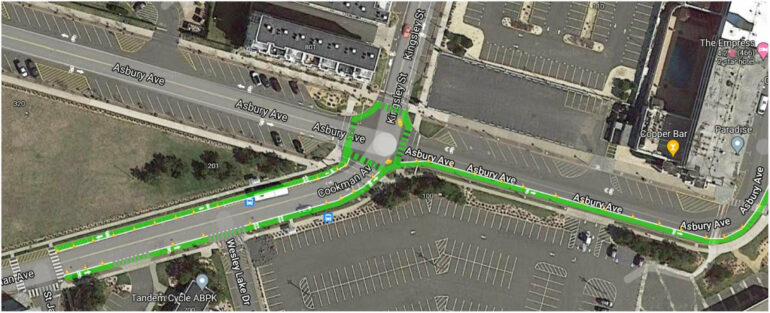New Brunswick researchers conducting a study at a high-traffic intersection in a Jersey Shore town have found that the installation of a bike lane along the road approaching the convergence reduced driving speeds.
As many traffic analyses have identified speeding as a contributing factor in a majority of crashes, inducing such a “traffic calming” effect with a bike lane could enhance road safety and decrease the risk and severity of crashes, the researchers said. The research was published in the Journal of Urban Mobility.
“We are giving you more evidence that bike lanes save lives,” said Hannah Younes, a lead author of the study and a postdoctoral research associate at the Alan M. Voorhees Transportation Center in the Rutgers Bloustein School of Planning and Public Policy.
“And it’s not only cyclists’ lives that could be saved. It’s more than that—drivers and pedestrians as well.”
The Rutgers team, which included experts from the Bloustein School, as well as from the Department of Civil and Environmental Engineering in the Rutgers School of Engineering and the Department of Computer Science in the Rutgers School of Arts and Sciences, focused their efforts on Cookman and Asbury Avenues in Asbury Park, N.J. Cookman, a local two-lane road, intersects with Asbury Avenue, a road that leads directly to the city’s popular Atlantic Ocean beaches.
Drivers heading to the beach often take a legal right-turn-on red at the intersection’s traffic light, gliding along the soft right turn from Cookman onto Asbury. However, Younes said, drivers frequently don’t come to a stop first, as required, but sail through, creating hazardous conditions for pedestrians and cyclists crossing at the corner.
The research team started by creating a temporary bike lane on Cookman and Asbury Avenues on the side of the road heading toward the beach, delineating it with orange road cones.
Bloustein students assisting the study then surveyed random bike and electric scooter riders using the temporary bike lane about their use of bikes and electric scooters, and their attitude toward bike lanes. Most people surveyed like bike lanes, the survey showed.
To analyze the effect of the bike lane on traffic speeds, the researchers employed computer vision techniques to classify the speed and trajectory of more than 9,000 motor vehicles. Computer vision is a subfield of AI that deals with the ability of computers to interpret and analyze visual data from the world. The researchers collected the data before creating the bike lane and after, for comparison purposes.
They found that the presence of the delineated bike lane made a difference: a 28% reduction in average maximum speeds and a 21% decrease in average speeds for vehicles turning right. For those heading straight and not turning, a smaller speed reduction of 8% was observed. In addition, drivers moving at a perpendicular angle to the bike lane did not slow down.
Marking the bike lanes with cones as a clearly delineated space was more effective at reducing speed than a painted-only bike lane. The painted-only bike lane was associated with a smaller speed reduction of between 11% and 15%, but only for drivers turning right.
Younes hypothesized that drivers slow down when they see a bike lane marked with cones because the driving lane is narrower and requires more concentration, and it’s easier to notice cones or planters or some other space delineator than it is to spot painted lines on the road surface.
With pedestrian deaths rising nationally, a study such as this could contribute to the development of new traffic policies or the reversal of older ones, Younes said. Cities nationwide are adopting policies that address eliminating all fatalities and serious injuries on public roads, such as the multi-national road traffic safety project, Vision Zero, for example, she said.
A total of 7,388 pedestrian deaths occurred in 2021, representing a 13% increase from 2020 and 17% of all crash fatalities, according to the Insurance Institute for Highway Safety.
Other researchers on the study include Clinton Andrews, a professor, Robert Noland, a distinguished professor, Wenwen Zhang, an associate professor and Leigh Ann Von Hagen, a managing director and adjunct professor, all from the Bloustein School; Jie Gong, an associate professor, and Jiahao Xia, a graduate assistant, from the Department of Civil and Environmental Engineering in the School of Engineering; Dimitris Metaxas, a distinguished professor, and Song Wen, a graduate assistant, in the Department of Computer Science in the School of Arts and Sciences.
More information:
Hannah Younes et al, The Traffic Calming Effect of Delineated Bicycle Lanes, Journal of Urban Mobility (2024). DOI: 10.1016/j.urbmob.2024.100071
Provided by
Rutgers University-New Brunswick
Citation:
Study shows traffic speeds decrease when bike lane is present (2024, June 3)



